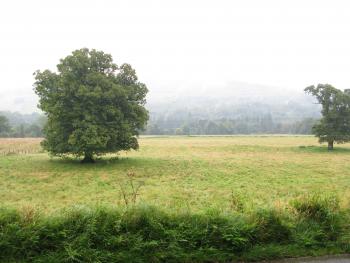- Navigation:
- Back to the Corpus index page
- RSS
Kenmore / Inchcadin / Inchadney / Inchaiden Parish Church
Kenmore, Inchadney Church, site 1
- Dedication: unknown
- Diocese of Dunkeld
- Deanery of Athole and Drumalbane
- County of Perthshire
- Perth and Kinross Council
- NN 7880 4680 ?
Historical outline
Dedication: unknown
Little recorded history survives for the church of Inchaiden before the sixteenth century. According to Alexander Myln in his Vitae Dunkeldensis Ecclesiae Episcoporum, both it and the church of Clunie were erected by Bishop Geoffrey into the prebend of the dean of Dunkeld.(1) This is corroborated by evidence from Bagimond’s Roll where both of those churches were recorded in 1274 as annexed to the dean’s prebend.(2) A vicarage pensionary was probably instituted at the time of the original annexation and the cure was still served in that way in the sixteenth century.(3) Vicars of Inchaiden are recorded in the sixteenth century, beginning with Donald McNaughton, who died at Perth in November 1523 and was returned for burial at his charge.(4) One of the most important burials noted at Inchaiden was that of James Macgregor, dean of Lismore and vicar of Fortingall, who was interred in the chancel in 1551.(5)
According to the Chronicle of Fortingall, religious worship, referred to as ‘prasyn’ and the holding of the market ‘was haldin and begwn at the Kenmor’ at the end of Loch Tay for the first time on 15 July 1575, and stopped at Inchaiden ‘quhar it was wynt tilbe haldin’.(6) This, it was stated, was effected by Sir Colin Campbell of Glenorchy. An undated note regarding the valuation of the churches around Loch Tay, undertaken as part of a commission established in 1617 to report on the condition of certain parishes in Scotland, refers to ‘Inchaiden alias Kenmore’, a style which could indicate that the relocation had indeed already occurred by that date.(7) The patronage of Inchaiden was purchased in c.1618 by Sir Colin’s son, Sir Duncan Campbell of Glenorchy.(8)
Notes
3. NAS GD112/2/71 no 15; Kirk (ed.), Book of Assumptions, 301 and n., 321.
4. Black Book of Taymouth, 118.
5. Black Book of Taymouth, 123.
6. Black Book of Taymouth, 140.
Summary decription
Nothing has survived of the medieval church at Inchadney, and, although its general location is known, its precise site can no longer be identified with certainty.
Architectural analysis
The medieval church, which is said to have been a rectangular structure, was sited at Inchaiden, about two kilometres to the north-east of the present building, and within what became the policies of Taymouth Castle. The churchyard remained in use for burials until about 1760, and the house that had been the vicarage was occupied as the parochial manse as late as 1780. The remains of the church, which were eventually dismantled in the early nineteenth century, were said to have been about 400 metres south of a holy well. A square stone basin that was found near the site of the church in 1922 is displayed in the porch of the modern church on the understanding that it was the medieval font. It has quirked angle rolls and the incised initials ‘AM’. However, a combination of its form and the absence of a drainage hole suggest that it is more likely to be a domestic mortar, albeit possibly dating from as early as the sixteenth century. As recently as 1938 the field officers of the Ordnance Survey recorded that the foundations of the churchyard wall could still be traced; but, although a slight platform may still be seen that could have been the location of the church, there can be no certainty about this, and recent efforts by those living in the vicinity to identify the precise site have been unsuccessful.
Although the church may have been relocated from Inchaiden to Kenmore as early as the 1570s, the present cruciform church at the latter, which occupies a prominent position on a promontory at the east end of Loch Tay was only built in 1760. It was possibly designed by William Baker, but was remodelled to its present form in 1870. Since 1996 Kenmore has been part of a linked charge with Fortingall and Lawers
Bibliography
Bowie, W., 1855, The black book of Taymouth, ed. C. Innes, Edinburgh, 28, 33, 118, 123, 140.
Cowan, I.B., 1967, The parishes of medieval Scotland, (Scottish Record Society), Edinburgh, 84-5.
Dunlop, A.I., 1939, ‘Bagimond’s Roll, statement of the tenths of the kingdom of Scotland’, Miscellany of the Scottish History Society, vi, 1-77, at 73.
Gifford, J., 2007, The Buildings of Scotland, Perth and Kinross, New Haven and London, 442-4.
Gillies, W.A., 1938, In famed Breadalbane, Perth, 56-7.
Kirk, J., 1995, The books of assumption of the thirds of benefices, (British Academy) Oxford, 301 and n., 321.
Kirk of Kenmore 1579-1979, 1979, Perth.
Royal Commission on the Ancient and Historical Monuments of Scotland, Canmore database.
Statistical Account of Scotland, 1791-9, ed. J. Sinclair, Edinburgh, xvii, 1796, 461.
Vitae Dunkeldensis Ecclesiae Episcoporum…Ad Annum Mdxv, 1823, ed. T. Thomson, (Bannatyne Club), Edinburgh, 10.
Map
Images
Click on any thumbnail to open the image gallery and slideshow.








